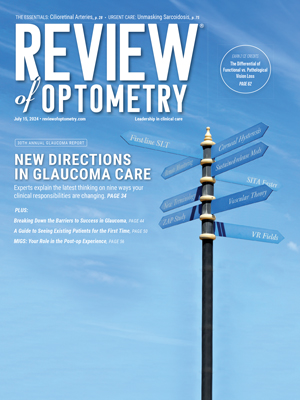Q A staff member was instructing a female patient on insertion and removal of her contact lenses, when I heard a scream from the adjacent room. I rushed over to see that the patients left eye prolapsed out onto her cheek. What should I have done in this situation?

A This is called globe subluxation and is actually becoming more common as ever more patients wear contact lenses. First, be sure the patient is comfortable and calm. These patients will be alarmed, frightened and in a lot of pain, says Andrew Gurwood, O.D., associate professor at the Eye Institute of the Pennsyl-vania College of Optometry in Philadelphia.
Patient relaxation is key in order to allow the orbicularis oculi muscle to relax and to make globe manipulation easier, adds Bruce Muchnick, O.D., also a professor at Pennsylvania College of Optom-etry. His advice: First, recline the patient. Sometimes the force of gravity is enough to allow the globe to slip back into the socket. Then, instruct the patient not to squeeze the subluxated eye (this will only push the eye out further), and not to squint the uninvolved eye.
Next, as the patient looks up at the ceiling, use your fingers to spread the patients lids around the front of the globe. Andrew Archila, O.D., of Sigonella, Italy, recommends using a cotton swab to roll the lids back. As you do this, gently push the globe back into place.
Dont push too hard, Dr. Gurwood warns. First, its not necessary; the globe naturally wants to move back to where it belongs. Second, with the slightest encouragement, subluxation can be reduced. Overreacting with excessive force may produce damage to ocular structures and/or the optic nerve.

A patient with globe subluxation.
When an eye subluxates, the lids no longer spread tears from the lacrimal lake across the cornea and conjunctival tissues, so the globe can quickly dry out. Use artificial tears along with a topical anesthetic to rehydrate those tissues and make the patient more comfortable. If this doesnt work, apply pressure to the anesthetized globe medially and laterally to the cornea using a traditional contact lens remover. You can relax associated blepharospasm by injecting lidocaine into the facial nervea maneuver you should reserve for only intractable cases.
After repositioning the globe, search for possible causes of subluxation. Rule out thyroid disease, orbital pseudotumor and retrobulbar space-occupying lesions. Other causes of globe subluxation include trauma, crying and stress.
Dr. Muchnick suggests visual field testing to rule out any resultant traumatic optic neuropathy.
Q Why does the globe subluxate? Is long-term treatment or comanagement required?
A Globe subluxation, also called luxatio bulbi, par-aphimosis and dislocation of the eyeball, often occurs as a result of thyroid disease, orbital pseudotumor and weight gain. Paraphimosis can occur due to any process that causes increased intraorbital volume, Dr. Much-nick says. This usually results in proptosis, then exophthalmos, and finally subluxation.
When pressure within the retro-bulbar tissues exceeds the forces counteracting proptosis, globe subluxation anterior to the eye may occur, Dr. Archila says.
Once proptosis occurs, the eye is susceptible to subluxation by any maneuver that raises the lid. Some examples: Goldman tonometry, slit-lamp evaluation, exophthalmometry, external evaluation and stereoscopic evaluation with a 78D or 90D lens. Crying, trauma and stress may also cause subluxation in a proptotic eye.
Treatment of paraphimosis involves reducing the orbital contents by weight loss to shrink orbital fat pads and by surgery to decompress the orbit, Dr. Muchnick says. Recurrent episodes in spite of orbital decompression may require tarsorrhaphy to reduce the size of the palpebral aperture and prevent subluxation.

